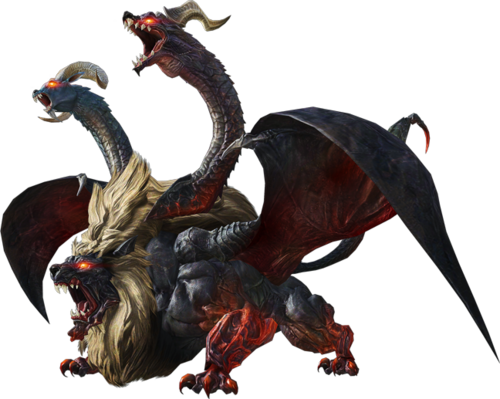Difference between revisions of "Category:Chimera"
| Line 1: | Line 1: | ||
[[file:Chimera render.png|500px|right]] | |||
{{other uses|the monster genus as a whole|the final boss of [[Cutter's Cry]]|Chimera (Boss)}} | {{other uses|the monster genus as a whole|the final boss of [[Cutter's Cry]]|Chimera (Boss)}} | ||
{{quotation|[[Encyclopædia Eorzea]] | {{quotation|[[Encyclopædia Eorzea]], p. 302|Simply stated, '''chimeras''' are creatures created by conjoining the flesh from two or more different beings. The process is highly complex, and was only perfected in the waning years of the [[Allagan Empire]]—the culmination of nearly an entire era's biological research. Despite recent findings which have shed more light on the process, replication of chimera-manufacturing techniques remains an impossibility within the scope of modern science.}} | ||
{{quotation|[https://na.finalfantasyxiv.com/a_realm_reborn/world/#!/bestiary/content?bestiary_03 A Realm Reborn Special Site]|The origins of this nightmarish combination of lion, goat, and dragon have been furiously debated. Some deem the creature a cruel jest of the gods, while others believe it the twisted creation of forbidden sorcery.}} | |||
==Lore== | ==Lore== | ||
Latest revision as of 00:12, 10 September 2024
 This article is about the monster genus as a whole. For the final boss of Cutter's Cry, see Chimera (Boss).
This article is about the monster genus as a whole. For the final boss of Cutter's Cry, see Chimera (Boss).
“Simply stated, chimeras are creatures created by conjoining the flesh from two or more different beings. The process is highly complex, and was only perfected in the waning years of the Allagan Empire—the culmination of nearly an entire era's biological research. Despite recent findings which have shed more light on the process, replication of chimera-manufacturing techniques remains an impossibility within the scope of modern science.
— Encyclopædia Eorzea, p. 302
“The origins of this nightmarish combination of lion, goat, and dragon have been furiously debated. Some deem the creature a cruel jest of the gods, while others believe it the twisted creation of forbidden sorcery.
Lore
The Sins of the Allagans
The wonder of aetherochemistry allowed the Allagan civilization to reach theretofore unmatched heights, granting them a nearly limitless power with which they could manipulate the very building blocks of Hydaelyn’s myriad creation. They could forge life anew, and by doing so take the final forbidden step toward godhood.
Yet the gods would not allow their halls to be corrupted by the taint of man, and so they cast the Allagans down from their pedestal in a great calamity of earth. Their creations, however, survived long after the fall of the empire, the truth behind their origins lost to time. The scholars of following eras assumed the beings to be natural, albeit twisted, and categorized them as they saw fit using distinct characteristics as guides. Naga were reptilian, so they must be scalekin. Chimeras bore the head of a lion and a ram, so they must be beastkin. It was not until the discovery of information locked inside receptacles of knowledge known as tomestones that the true nature of the blasphemous creatures and their wicked evolution was brought to light.
The First Generation
The first chimeras were crude creations-forbidden marriages of two seemingly dissimilar creatures, one serving as a "medium" to serve as host, the other as a "catalyst " to incite a transference of characteristics. What traits from the catalyst would manifest in the host could not be predicted with any accuracy, leaving mach of the process to chance. The result was countless expensive "failures" that required suffering while awaiting the emergence of an acceptable subject. What is worse, the resulting chimeras were all infertile, meaning that the only means for mass production of the creatures was via cloning techniques that, at this time, had yet to be perfected. As a result, very few of these first-generation chimeras still exist today.
The Second Generation
As aetherochemists continued their first-generation trials, the process of splicing biological information from one creature into another grew more refined. Scientists could now isolate certain traits from the catalyst and transfer those to the medium with a high rate of success. This breakthrough succeeded in both significantly reducing the probability for test failure while also solving the problem of infertility. Second-generation chimeras could reproduce on their own, removing the need for costly and time-consuming cloning and opening the door for military mass production.
The Third Generation
Chimera development took its next step forward following the discovery of methods allowing traits of multiple catalysts to be spliced into a single medium. Yet, while the incorporation of additional characteristics led to more complex and diverse creatures, maximizing strength, agility, and intelligence, the resulting abominations proved unsound of mind. Many and more would simply refuse to take orders, attacking their siblings, or even their creators. The scientists were forced to watch as the sanity of their creations collapsed in on itself, rendering the beasts useless masses of quivering flesh.
The Fourth Generation
As the Third Astral Era neared its end, Allagan actherochemists finally succeeded in stabilizing the psychological deficiencies present in many of the third-generation chimeras, the result being what was ultimately hailed the perfect construct. Not only did the fourth-generation creations exhibit strength and intelligence rivaling that of even a spoken, but they were no longer prone to the erratic behavior that plagued the past generations. To achieve this, however, the Allagans would test their very moral limits, electing to perform their research on beastmen and even members of the five races. As a result, near-flawless creations such as the shabti and the iksalion were achieved...but at what price? [1]
All creatures belonging to the class Chimera.
- ↑ Encyclopaedia Eorzea: Volume I, page 302
Subcategories
This category has the following 17 subcategories, out of 17 total.
E
G
H
I
L
M
N
P
R
S
Z
Pages in category "Chimera"
The following 98 pages are in this category, out of 98 total.
